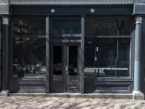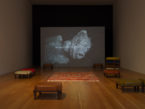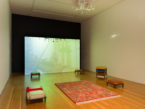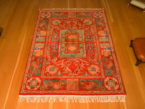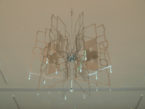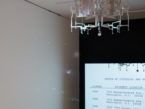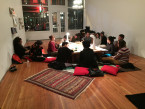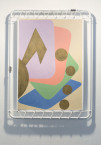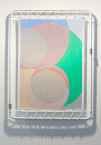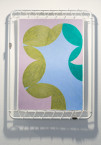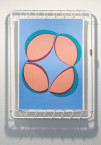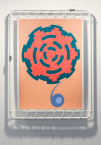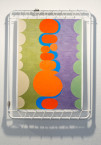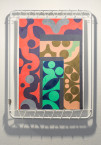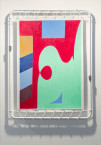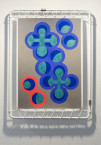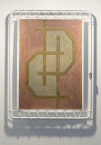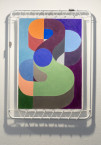Artspeak
-
Director/Curator 2016–2022.
Exhibitions
-
GELARE KHOSHGOZARAN
April 2–May 14, 2022Gelare Khoshgozaran’s film installation Royal Debris (2022) is informed by her decade-long research about the shuttered former Embassy of Iran in Washington D.C. Located at 3005 Massachusetts Ave N.W., the vacant building embodies a contradiction: it is a ruin due to its deteriorating condition caused, in large part, by the ongoing US sanctions on Iran, and it is privileged with an exceptional protection thanks to its ‘foreign mission’ status. Taking the building’s symbolic and material status as its departure point, Khoshgozaran’s film is a rumination on borders, displacement and ruination through excursions into family history, architecture, poetry and contemporary art.
Royal Debris brings together several works that implicate the viewer in a continuous sense of displacement between a diasporic home and an institutional archive. A bespoke persian rug was designed to incorporate the flora and fauna foraged from in and around the buildings of the former Embassy and Consulate General of Iran, respectively in Washington DC and New York City. The style of the included Ottoman footstools were identified by Khoshgozaran from the archival photographs of the former embassy’s “Persian Room.” The viewing experience of the film is distorted by a custom designed chandelier hanging from the ceiling, creating a dispersive refraction of the moving image throughout the space of the gallery. The installation thinks through the production of a space that is conditioned by the limitations of an archive, its artificiality, and its simultaneous order and disorder.
* * *
This project could not be possible without the support of: Hande Sever, Hugo Cervantes, Hailey Loman and Los Angeles Contemporary Archives, Aria Safar and Mehrshid Alai-Safar, Andrea Steves, Shiva Balaghi, Mona Kareem, Los Angeles String Quartet and Felix Vologanin, Azin Seraj, Jimena Sarno, Sina Fakour, Saeed Khoshgozaran and Parvaneh Madani, Alexandre Saden, Jake Viator, and musicians Ariana Solotoff, Enosh Kofler, Boryana Popova, and Mark Bassett.
The research for Royal Debris was supported by the Graham Foundation.
The project was funded, in part, by a Foundation for Contemporary Arts Emergency Grant.
-
I Am Porous. And I Am Moved By You.
WOOJAE KIM
November 5–December 11, 2021i.
While Woojae Kim has been in residence at Artspeak over the past few weeks, he has been setting up the conditions to cultivate microorganisms to support the production of makgeolli (막걸리). Makgeolli is a Korean fermented rice wine that takes a minimum of 8 weeks to produce. Its taste and consistency are determined by the environmental conditions of its production. The process of making makgeolli reflects wider inquiries within Woojae’s artistic practice, and is analogous to the time and care that are required in the relationships we each maintain. These inquiries also extend to questioning the ways we use language. He notes that words such as colonization, biodiversity, diversity, and culture are all used in scientific contexts. These same words are also frequently used in wider socio-cultural contexts with very different interpretations. Querying our comprehension of these words and concepts, we are asked to unsettle and anchor these terms within specific material realities.
ii.
The full makgeolli making process requires methodical care and attention to cultivate and set the optimum conditions for the ‘good’ funghi to thrive. This process is detailed here*. The creation and establishment of the nuruk (누룩, fermentation starter) can take up to four weeks to cultivate fungi (desirable mold and yeast). Created from microorganisms of particular places, the nuruk in this installation contains bacteria from different areas: the neighbourhoods of Mt Pleasant, Pacific Spirit Park in Point Grey, and from in and around Artspeak. Set within a box to encourage mold cultivation, the nuruk requires specific conditions: resting on natural foliage foraged from a wooded area in and around Vancouver, within an ideal temperature of between 30-35 degrees Celsius. Once desirable mold colonies become settled, the nuruk is dried and mixed with rice to make makgeolli. This takes another 4 weeks as the nuruk breaks down the starch and proteins within the rice transforming it into makgeolli. The different batches are carefully labelled with dates and place, to monitor each step in the process.
The materials for the bricks and cups are also gathered and collected locally. The bricks, made from clay, sand, silt, and straw, are constructed in a way that holds, but from material that will easily disintegrate. The cups are made from clay gathered along the Fraser River, near Fort Langley. Like the bricks, their material composition also allows them to decompose naturally. These material decisions are guided by his own consideration of his position here as an uninvited settler to these lands on unceded territories.
iii.
Photographic prints that fade are images that refuse permanent capture. Using a chlorophyll printing process, the rate at which the series of photographic prints will fade is dependent upon their exposure to UV light. Making his own chlorophyll solution, Woojae extracts dark deep greens from particular plants. The material composition of the chlorophyll solution ensures that the visibility of the image only remains temporarily.
This temporal aspect of Chlorophyll Prints counteracts the function of photographic processes to capture and to fix. Building in the degradation of the image over time loss of clarity contests the formal document’s reliability to carry the true memories and stories surrounding the production of the image. The refusal of a permanent record only grants viewers a temporary glimpse. The prints are of the artist’s family. Their presence in the space is significant. Over the past couple of years Woojae has been regularly connecting with his Grandmother in Korea, with much of their time spent sharing recipes and cooking together. The images that hold steady regardless of material conditions are frequently the ones that refuse to fade from memory.
iv.
Over the course of his residency, Woojae has been recording sounds from the different stages of the process of making makgeolli. These recordings were sent to artist William Bradley, who created new compositions. Powered by a solar panel, the handheld device is weighted by a rock and plays compositional variations. The sound compositions allow us to become attuned to the activity of the microorganisms, and of their work in breaking down the starch and protein of the rice as it is transformed into makgeolli.
Listening in this way proposes thinking and observing at another scale. These compositions capture the emergent, recurring, repetitive process of production, on a path towards material transformation. Transformation occurs beyond words, beyond definition, at a different sensory scale of comprehension.
v.
There’s a sense that the works in the space are inching towards the window, towards the sun. They require specific conditions to exist. They cannot be contained and isolated in the space. Nuruk needs the sun, warmth, and humidity to thrive; the sound composition device relies on the solar panel as a source of energy; and the Chlorophyll Prints are to be exposed to UV light to render their image temporary. Working with live organisms requires a close and careful negotiation of place. Their continually shifting needs and characteristics demands a nuanced understanding of how to achieve stability within specific environmental conditions. These negotiations reveal deeper time scales, layers of history and stories of place. They are a reminder that we are only passing through temporarily, sharing this place with other humans, non-humans, and the more than human.
Postscript 80: Sean Alward, Laiwan, and Marina Roy on Woojae Kim
-
– May Day – Mayday – Maydaze –
ALY DE LA CRUZ YIP, HO TAM, TANIA WILLARD
May 1–June 12, 2021– May Day – Mayday – Maydaze – features three new print commissions by aly de la cruz yip, Ho Tam, and Tania Willard, organized by Artspeak and Moniker Press. With a focus on print and publishing methods designed to meet urgent needs and modes of distribution, we opted for the effectiveness of risograph printing. The risograph prints and wallpaper are displayed in the window space at Artspeak, while the gallery remains closed to the public. These prints are available for purchase via Artspeak and Moniker Press, with all proceeds going to the DTES Response Fund.
The artists included in this show are known for their consistent engagement with expanded printmaking and publishing techniques. We were drawn to the ways their artistic practices are informed by and firmly grounded in their commitment to organizing in their respective communities. aly de la cruz yip is a member of WePress collective: a group of artists and community organizers who work to promote self-expression by providing workshops on historic and contemporary methods of print and art making for the community of the Downtown Eastside. Ho Tam runs a press and bookshop/gallery, providing a space for artists and cultural producers whose practices frequently question and complicate the idea of the Nation State. Tania Willard runs the collaborative project BUSH Gallery; a conceptual, land-based gallery grounded in Indigenous knowledge and relational art practices.
aly de la cruz yip’s work combines multiple mediums, gravitating towards analogue techniques such as letterpress, blockprinting and silkscreen. de la cruz yip’s work brings together sensory imagery familiar to the neighbourhoods of Chinatown and the Downtown Eastside. Featuring ginkgo leaves, chrysanthemum buds, floating joss paper, and a reclamation of their bat relatives, find home in ritual is reminiscent of a stroll down East Pender Street in early spring.
Ho Tam’s The Greatest Stories Ever Told is an extension of an artist’s book series of the same title. So far, Tam has produced different variations of this book in 14 different languages. The collages therein utilizes images taken from banknotes. Removing these symbols of significance from their intended context as the design of national currencies, Tam brings into question ideological narratives of the Nation State. Which stories and historical figures are perpetuated, circulated and given value, and how can we reconfigure what constitutes value?
Tania Willard’s Memorandum of Understanding is a continuation of a query around land and value, from a series of work Snowbanks and other Investments(2020). Memorandum of Understanding pairs legalese with representations of land to consider the way bureaucratic processes and language assert land rights. The legalese of colonial institutions is a firm reminder of the different understandings underpinning our relationships to land.
An edition of 100, these prints are available for purchase via Artspeak and Moniker Press, with all proceeds going to the DTES Response Fund.
– Bopha Chhay and Erica Wilk
-
BIG ROCK CANDY MOUNTAIN, STEFFANIE LING, STEVE HUBERT, CHARMAINE LEE, DASHES, BARBARA LAZARA, CHRISTINA BATTLE, RAVEN CHACON, SYDNEY HERMANT, SAMANTHA NOCK, LINDSAY MCKINNAN, MELISSA ANDREWS, DAVIDE BALULA, KAITLYN PURCELL
June 23–August 11, 2020Tuesdays, 9–10pm
Vancouver Co-op Radio, CFRO 100.5FM
coopradio.orgWhile staff have been working remotely, we wanted to find ways to remain connected to the neighbourhood and communities surrounding Artspeak. With the temporary closure of the gallery, we’ve decided to renew a feature of Artspeak’s programming of the past years: radio broadcasting. We’re excited to continue to work with Vancouver Co-Op Radio, for another edition of Artspeak Radio Digest. Located a couple of blocks from Artspeak, Vancouver Co-op Radio is a community radio station that has been based in the Downtown Eastside since 1973. In Fall 2018 Artspeak Radio Digest was collectively run by Brady Cranfield, Gabi Dao, Emma Metcalfe-Hurst, Autumn Schnell, with support from myself and Erik Hood.
As an audio journal, Artspeak Radio Digest is an expanded approach to our publishing program. In the true form of a digest, over the next several weeks of the PROXIMITIES EDITION, we will be hosting many exceptional artists, writers, arts workers and musicians. All of who maintain an interdisciplinary practice and work with sound, voice, publishing, and writing.
For the duration of PROXIMITIES – we’re very excited to be introducing – Hannah Jickling and Helen Reed of Big Rock Candy Mountain who will be our resident guests on the show presenting Bubble Broadcast. Each week they will be sharing their research as part of their Sleepy Soda project, which will develop a special edition of soda with grade 6 students in Edmonton, Alberta.
As the goal posts keep shifting, and it’s difficult to know when we can gather in ways that feel familiar, we hope to share with you via Artspeak Radio Digest a series that will allow us to share space together in auditory proximity.
-
LAIWAN
June 14–July 27, 2019With Egan Davis, Anne Riley, T’uy’t’tanat Ceass Wyss, Melissa West Morrison and Marika van Reeuwyk of the Environmental Youth Alliance, Sepideh Saii, Daniel Negatu, and brothers Frank and Dance Williams.
Situated a short distance from Artspeak at the corner junction of Carrall, Water, Alexander and Powell Streets was formerly the site of Maple Tree Square. Laiwan takes the historic site of the Square as a starting point for her research project Maple Tree Spiral: the pedagogy of a tree in the city. The original Maple Tree no longer stands, and instead a statue of ‘Gassy’ Jack Deighton. As a site where one of the first city council meetings of the settlement of Gastown was held, Laiwan considers how Maple Tree Square is a space of convergence.
Maple Tree Spiral is a research project studio residency that will remain in process over time in the gallery, being shaped through events and activities with a number of contributors and with a practice dedicated to a wider understanding of trees as a way to reorient and reconfigure how we inhabit the city and urban environment. During this time at Artspeak, Laiwan will present several works informed by her research, as well as a place to share people’s tree stories, and a site of gathering for events that will take place over the course of the project.
Laiwan’s interdisciplinary research maintains a rhizomatic methodology proximate to Donna Haraway’s assertion of a deeply embodied praxis that lends itself to better comprehending and articulating multispecies sociality. Haraway has frequently spoken of the ‘… need for other kinds of stories’, particularly ones that draw attention to the relationship between human and non-human forms living alongside one another. Put simply, to shift our focus and attend to what is already there. Maple Tree Spiral draws upon what is not immediately perceptible in our urban environment.
When we first began speaking about Maple Tree Spiral, Laiwan sent me an image of Goethe’s Oak, followed by an image from her work ‘C A V E: C A V E A T’ of an engraved print of a large tree in a labyrinth. Within the labyrinth are people actively conversing; and in close proximity a Minotaur is seen digging the earth, as if trying to get out. We know this image to be a depiction of The Labyrinth of Crete from Greek mythology. Central to many stories of trees is their role as monuments both mundane (as wayfinding markers) to that of bearers of knowledge, as witnesses, and integral to philosophical and religious concepts. During my year of correspondence with Laiwan, our line of questioning around trees in the city would incrementally shift to an attentiveness of the trees we live alongside. Informed by a site-specificity in her research and practice, Maple Tree Spiral questions the narratives we are attuned to, the ones that we want to deviate from, and the ones we want to write and hear.
Meeting with several individuals and organizations over the course of a year, Laiwan started to build an informal constellation and network of relationships with the objective of how to better care for trees in our immediate environment. Laiwan describes the building of these relationships and partnerships between human and non-human forms as a process of ‘sympoiesis’ – collectively created, produced and organized, without a central node. Another term, which nuances the decentralized nature of entangled relationships that Laiwan has mentioned, is ‘holobionts’ – assemblages of different species that remain in progress and are highly interdependent. Maple Tree Spiralfosters entangled ways of knowing that allow for a reading and writing that incites other ways of living and imagining the world.
Laiwan would like to thank Hannah Doyle, Mae Stark, Marc Hanson, Cynthia Low, Britannia Community Centre, Sharon Bayly, Mrs. Chin Kow Chung, Harmony Gardens X̱wemelch’stn pen̓em̓áy, City of Vancouver Arborists Troy Hudson, Jeff D’Altroy and Terry Marshall, Karen Henry, Douglas Justice, Dana Cromie, Dan Guinan at the Native Education College, and the BC Arts Council.
-
BRADY CRANFIELD, GABI DAO, EMMA METCALFE-HURST, AUTUMN SCHNELL, BOPHA CHHAY, ERIK HOOD
September 18–November 27, 2018Artspeak Radio Digest is a three month long program, run in partnership with Vancouver Co-op Radio a community radio station based in the Downtown Eastside since 1973. Taking the form of an audio journal, ARD is an expanded approach to the organization’s publishing program. Each show has been conceived as an issue of an audio journal. Interdisciplinary in its approach, the digest format will feature new commissions, sound works, poetry, radio plays and music amongst other forms utilizing radio as a medium. The program will be collectively produced and hosted by Brady Cranfield, Gabi Dao, Emma Metcalfe-Hurst and Autumn Schnell with support from Bopha Chhay and Erik Hood.
The form of radio can seem overtly nostalgic. Why radio? Why now? Artists have long harnessed airwaves as a medium. Radio has long provided a distinct alternative for the presentation of artistic practice outside of the gallery. Radio shifts focus from the visual to the aural, challenging visual primacy in artistic practice. Co-op’s programming has included shows by artists since it’s founding. These include the long-standing Soundscape, first founded by Hildegard Westerkamp, The HP Radio Show hosted by Hank Bull and Patrick Ready and Lux Radio Players.
Airwaves as a medium presents other challenges. Seemingly intangible, airwaves do not escape commodification, as corporations jockey for licensing rights. Actively working to counter commercial interests, Co-op’s community based programming remains distinct in its prioritization of perspectives, forms and voices not heard through conventional media avenues. Public broadcast regulations dictate what we can say and play during certain hours, as we’re obligated to abide by national broadcasting standards. There are things we can say, things we can’t say and things we won’t say. In Canada, after 9pm, restrictions and quotas ease up. Be sure to tune in weekly to CFRO 100.5-FM beginning Tuesday, September 18, 2018 from 9 to 10pm PST for the first issue of Artspeak Radio Digest.
Thank you to our partners at Vancouver Co-op Radio, Robert Moya and Kimit Sekhon.
ARD is part of year of programming at Artspeak that considers ways of learning and studying together as a collaborative process and practice. Upcoming programming will challenge the role of the artist-run center, notably asking how it can contribute to creating space allowing for new forms of engagement to reimagine current limits in cultural production and shape alternative practices. Before the rain really sets in, we’ll take a short hike to Mount Seymour where Co-op’s Transmitter has been located since 1982.
-
CHRISTIAN NYAMPETA
March 3–April 21, 2018Christian Nyampeta’s exhibition ‘In The Meantime’ is a continuation of his research into modes of working together and being in common. ‘In the Meantime’ is a hosting structure and working space that is a meditation on the process of translation as a continual work-in-progress. A selection of Nyampeta’s publications will include his translations of selected texts from Alain Mabanckou’s Penser et écrire l’Afrique aujourd’hui, an edited volume containing lectures delivered at the Collège de France in 2017 by Souleymane Bachir Diagne and Lucy Mushita among others. The nature of translated texts is that they always exist ‘in the meantime.’ Dependent upon the context in which they were translated, they remain open to various interpretations by their readers. The processes of translation becomes a form of sociality; one that creates, annotates, records, and interprets together. In this way, one never reads alone, but always with and alongside others. Differences between translations evoke concurrent or parallel forms of reading and legibility, unfolding ‘within’ and around an original frame of reference.
In recognizing the limits of translation and the malleability of interpretation and meaning, Nyampeta focuses on ‘rhythm’ as a discursive tool to ad- dress political and ideological shifts in philosophy and religion in former colonies. In his film ‘Comment vivre ensemble,’ Nyampeta interviews a number of Rwandan philosophers and educators, asking “What is rhythm for you?” This question of how people define rhythm is part of Nyampeta’s ongoing project ‘how to live together’ 1. Taking cues from Roland Barthes lectures also held at the Collège de France in 1978, Nyampeta’s study of the historical notion of idiorrhythmy considers rhythm as the organization of one’s own space and time, and the role of rhythm in how it shapes our subjecthood, our communities and our localities. Through this notion, Nyampeta investigates how rhythm has the capacity to regulate, or be regulated by patterns and movements, to form or disrupt them.
Rhythm is not only an index of difference, but generative in its potential to work towards invention or reinvention. This translative capacity of rhythm also questions Barthes’s own silences about his familial connection to the colonial legacies of France, as narrated by Ivorian writer Gauz in Penser et écrire l’Afrique aujourd’hui, whose text is also translated for this occa- sion. ‘In the Meantime’ situates this query, in a manner that is equivocal to the function of the parenthesis. It becomes a permissive space, in which we might wait for something to happen, or a time and space outside of our control, or a time during which we contemplate action.
1 Idiorrhythmy is the subject of the lectures held at the Collège de France by the French literary critic Roland Barthes in 1978, titled Comment vivre ensemble: simulations romanesque de quelques espaces quotidiennes, ed. Claude Coste (Paris: Seuil, 2002), and translated as How To Live Together: Novelistic Simulations of Some Living Spaces, translated by Kate Briggs (New York: Columbia University Press, 2013).
-
VALENTINA DESIDERI, DENISE FERREIRA DA SILVA
November 24–December 16, 2017with
JUSTINE A. CHAMBERS, AMALLE DUBLON, STEFANO HARNEY, MARIANA MARCASSA, BYRON PETERS, AND CONSTANTINA ZAVITSANOSHealing, as much as art, is a praxis. It is something to do and it does something: it restores. In their collaborative work, Valentina Desideri and Denise Ferreira da Silva explore healing as an art form, a praxis of sensing and making sense that includes studying, thinking, reading and restoring experiments that reach for the deepest level of our entangled existence. Ferreira da Silva and Desideri will host a Sensing Salon at Artspeak—a studio for the practice of healing arts—where different reading and healing tools will be shared and available for use, such as Tarots, medicinal plants, Fake Therapy cards, books, Astrology, Reiki, etc.
The Salon will also host sessions of Poethical Readings, a study group dedicated to experiments in entangled existence. Invited artists Constantina Zavitsanos and Amalle Dublon will share their practice of Astrology through a public reading and a workshop. Valentina Desideri will lead a one-day workshop to share her practices of Fake Therapy and Political Therapy. Invited artist Justine A. Chambers will host Rest to Move to Rest a workshop that will consider the space between rest and simple repetitive movements adapted from social dance, somatic practice and western contemporary dance.
In partnership with the Critical + Creative Social Justice Studies Research Program, UBC Social Justice Institute, during the Sensing Salon, Artspeak will also host an iteration of the Elemental Panel: AIRWAVES: Anti-Colonial Methods. The Elemental Panels program assembles academics, artists, and activists whose contributions to critical racial, anti-colonial, and feminist thought and practice draw from the signifying richness of the elements—air, water, fire, and earth.
The Salon will be open and available for use Thursday to Saturday, 12–5pm punctuated by weekly contributions and events by the invited guests and artists.
* SCHEDULE *
FRIDAY, NOVEMBER 24, 8PM
Introduction to the Sensing Salon with Valentina Desideri and Denise Ferreira da Silva
GPS Reading with Constantina Zavitsanos and Amalle DublonConstantina Zavitsanos and Amalle Dublon will introduce their approach to Astrology as alternative time keeping (and time spending) device by conducting a public reading for Artspeak’s natal chart.
SATURDAY, NOVEMBER 25, 2PM
GPS Workshop with Constantina Zavitsanos and Amalle Dublon
Constantina Zavitsanos and Amalle Dublon will give an introductory workshop on the speculative planning practice of astrology. They will explain some of the basic structures and elements that compose an astrological chart, focusing on the vocabulary they employ for reading.
THURSDAY, NOVEMBER 30 and
THURSDAY DECEMBER 14, by AppointmentPoethical Readings sessions with Ferreira da Silva and Desideri
What if, instead of providing a resolution, a direct answer, or a definite interpretation, a reading helped us to navigate the complex reality, its different positions, relationships and layers that also constitute us? Every reading exposes possibilities, reveals blockages and shifts perspectives. Beyond the principles of non-contradiction and identity, readings design a space where multiple articulations of situations and events coexist without the imposition of a single meaning or direction.
Drawing from each other’s practices Denise Ferreira da Silva and Valentina Desideri come together for experimental readings. They experiment with ‘reading tools’ inspired by well-known and newly-designed practices—such as the Tarots, Political Therapy, Palmistry, Fake Therapy as well as Reiki, Astrology and Philosophy. Relying on the kind of knowing that Walter Benjamin calls mimetic (intuitive) faculty and Carl G Jung associative thinking, these tools assemble a reading or an image. Reading as imaging, in their practice, consists of an assembling that exposes and navigates the complex context constituting the situation, event or problem that concerns a person or collective at a given moment and place. As such, it aims at expanding the horizon of interpretation, that is, to open up possibilities and unsettle realities.
How does it work? Each session, attended by an individual or small group (5 people maximum), will last for about 45 minutes. There is no need to come with a well-defined question. For ‘the question’ can also come up during an initial reading and it can be further narrowed or expanded when addressed by other tools.
Please call Artspeak to book an appointment at (604) 688-0051. November 30: 3pm, 4pm, and 5pm; December 14: 4pm, 5pm, and 6pm
SUNDAY, DECEMBER 3, 2PM
Elemental Panel: AIRWAVES: Anti-Colonial Methods with Stefano Harney, Mariana Marcassa + Byron Peters
Presented in partnership with the Critical + Creative Social Justice Studies Research Program, UBC Social Justice Institute.
Artspeak and UBC’s Social Justice Institute invite you to a conversation inspired by the element air. This conversation is part of Anti-colonial Methods, which is a series of events—panels, workshops, screenings, performances, conversation, writings—in which we would like to explore the synergies and tensions between critical and creative work that engage ongoing colonial and racial violence in their various (total, symbolic, subtle, overt, unexpected, quotidian, casual, official, … ) modes of actualisation. Inspired by four elements (air, fire, water, and earth) we hope to create space for and support conversations that spark our imagination and both sustain the anti-colonial practices in which we are already involved and the ones yet to be unleashed.
The Critical + Creative Social Justice Studies Research Program offers learning, research, and practice opportunities to students interested in creating artistic work that engage with critical tools and formulations developed in critical, racial and anti-colonial, feminist, queer, and trans* scholarship. Focusing on the potential of the creative work to disrupt ingrained ideas and representations through affecting the senses and the imagination, this research program sits at the intersection of art, activism, and academic work.
TUESDAY DECEMBER 5, 7PM
Sound Journeys with Mariana Marcassa
In this workshop individual participants will travel through the various sound landscapes created by Mariana Marcassa’s intuitive curation of instruments. As a collective they will also be guided to experiment with their own as well as with the voices of others.
THURSDAY, DECEMBER 7, 7PM
Study Group: Experiments in Entangled Co-Existence I with Denise Ferreira da Silva and Valentina Desideri
In these sessions, we will read and discuss texts in philosophy, and art & political theory as well as experiment with practices of entanglement. Anybody taking part in the study group is invited to bring in further texts, practices, exercises, side-thoughts and intuitions that could potentially contribute to our study.
We will be starting with Stefano Harney and Fred Moten’s text Improvement and Preservation, or, Usufruct and Use
SATURDAY, DECEMBER 9, 2PM
Fake Therapy and Political Therapy with Valentina Desideri
Valentina Desideri will share and transmit her practice of Fake Therapy and Political Therapy. Fake Therapy is a practice between two persons that stimulates and reactivates the sometimes hidden capacities of anyone to heal anyone (or anything) else. It is a practice autonomous of disciplinary origins and refuses expertise or any form of knowledge-authority. While Political Therapy is a one-to one performative format that creates the condition for conversation and some speculative thinking around political issues, via the body.
Appointments can be made for the 15th. Available time slots are 12, 1:30, 3 and 4:30pm. Please call the gallery to book an appointment. 604.688.0051
THURSDAY, DECEMBER 14, 7PM
Study Group: Experiments in Entangled Co-Existence II with Denise Ferreira da Silva and Valentina Desideri
In these sessions, we will read and discuss texts in philosophy, and art & political theory as well as experiment with practices of entanglement. Anybody taking part in the study group is invited to bring in further texts, practices, exercises, side-thoughts and intuitions that could potentially contribute to our study.
Starting with Stefano Harney and Fred Moten’s text Improvement and Preservation, or, Usufruct and Use
and notes from the previous group Entangled Socialities II – Pursuing the Question of ValueSATURDAY, DECEMBER 16, 2PM
“Rest to Move to Rest” with Justine A. Chambers
In this workshop participants will alternate between rest and simple repetitive movements adapted from social dance, somatic practice and western contemporary dance. By practicing individually while together, participants will work with a gentle awareness on the transmission of felt information between bodies. We will practice movement to rest our minds, and return to rest to feel the perpetual movements of our bodies.
Thank you to our partners University of British Columbia Community Engagement and
the Critical + Creative Social Justice Studies Research Program, UBC Social Justice Institute. -
ANNE LOW
September 9–October 28, 2017In The Ormolu Clock a short story by Muriel Spark the narrator is staying in the well kept but modest Guesthouse Lublonitsch. The focus of the story revolves around the narrator’s observation of Frau Lublonitsch, the proprietor of the guesthouse. Despite her rumoured wealth she still maintained the modest dress and work habits more reminiscent to that of a peasant. At one point in the story the narrator catches a momentary glimpse into a room through a door, that up until that moment, had remained locked. The narrator’s description of the magnificence of the room revealed a canopied bed, stacked with plush pillows, highly adorned quilts and Turkish carpets all in hues of deep crimson, dark wood and flashes of gilded gold, a glistening tiled stove and an elaborately decorated clock. The narrator is struck by the opulence of the bedroom, seemingly the antithesis to the rest of the establishment with its humble scrubbed and polished wooden interior. Before closing the door an employee mentions that the room is Frau Lublonitsch’s bedroom.
Anne Low’s new body of work Witch With Comb carries a similar sentiment to this momentary glimpse into the bedroom as described in The Ormolu Clock. Beginning with ingress to The Ugly Room (2017), the shutters at the entrance; viewed from the street, partially opened, they hint at a space lived in. In their form and material the sculptural works within the exhibition consider our relationship to the domestic spaces we inhabit, raising questions about the ways we chose to decorate and adorn these spaces and the objects we chose to live with.
The proprietor of the room is present, but only in the form and material of the sculptural works. We’re clued into the daily rituals and the relationships they’ve formed with these objects within the space. These works were formed by the familiarity and intimacy of their proprietor. Accumulated crumpled notes and papers, unopened letters, a cut out of Durer’s Avarice, sit atop a well worn, discoloured pillow and bed. Their haptic arrangement is as if they’ve been emptied out from the bottom of one’s bag or bottom drawer, temporarily forgotten, only to later be revisited. How do collections of found objects, trinkets and miscellany, placed alongside and within sculptural works, affect each other? Has their former utility been completely relinquished? Is there a sense that they’ve shirked their preciousness, or a need for preservation as they adorn and share the surface of the handwoven fabric. The presence of these sculptural works adheres not only to the private sphere of their owners taste, habits and desires, but also expanded interpretations of objects and materials and our subsequent relationship with them.
-
Yesterday, In The Years 1886 and 2017
STEPHANIE COMILANG
June 10–July 29, 2017“Sunburned flesh
We enter a new space
I clip into the vestibule and right away
I am ash baked
These storybook villas still dream behind shutters
Their balconies fine as handmade lace
I am the colour of burnt pineapple, lemon, mango”“Yesterday, In The Years 1886 and 2017” is a two-channel video projection installation. The two protagonists José Rizal and Lourdes Lareza Müller occupy a channel each; projected adjacent to one another, they inhabit the same space while remaining distinctly separate. José Rizal (1861-1896) was a Filipino nationalist, considered a national hero for his advocacy and thinking that led to the Philippine revolution against Spanish rule. While he worked as an ophthalmologist he was well known for his literary works. While living in Berlin he completed his book “Noli Me Tángere (Touch Me Not)” in 1887, a book that many have credited for its proposition of nationalism and resistance to Spanish colonial rule through its formulation of the idea of an ‘imagined community’1 in the Philippines. Lourdes Lareza Müller is the other protagonist in “Yesterday, In The Years 1886 and 2017”. Having migrated to Germany in 1968, she worked as an archivist at one of Europe’s largest libraries, Berlin’s Staatsbibliotek, for 28 years.
The thread that ties these two figures is their life in Berlin, away from the Philippines. The disembodied feminine voice remains unidentified throughout but narrates from a distant future. She hovers and is distinctly non-human and speaks of inhabiting both Rizal and Lareza Müller in human form. Positioned as a third protagonist, she speaks of a connectedness through adaptation, bodies as archives, and entangled narratives of possible futurities. While this film speaks to a specific place and particular people, the role of the disembodied narrator, casts a wider net of questions around mobility, a rearrangement of geographic concepts of centre/periphery, and the disruption of historical linearity and continuity.
Music by NaEE RoBErts and Elysia Crampton.
¹ The concept of ‘Imagined communities’ was coined by Benedict Anderson.
Postscript 70: Danelle Ortiz on Yesterday, in the years 1886 and 2017
-
Milman Parry’s Waiting Room Rhapsody
JULIAN HOU
April 1–May 20, 2017The Guild of Rhapsodes, a wandering band of orators, was most prominent in classical Greece between the 4th to 6th centuries BC. Rhapsode is translated as ‘singer of stitched words’. The craft of the guild conjures up the spectre of Milman Parry, the renowned scholar of epic poetry. Parry’s study of Homeric epic poems and his defence of oral traditions was significant in his argument against the idea of single authorship and questioning of whether so much weight and emphasis be placed on the ‘original text’. The work and craft of the guild required of them to carry a collective responsibility in ensuring the transmission of oral histories in the form of epic poetry. Acting as custodians of these stories, the cultural values and norms within these narratives were mediated through the bodies of the guild.
Waiting rooms encourage you to be still, quiet, patient and contemplative. The stillness is not for your privacy. Other bodies may or may not be present. The furnishings and décor remain non-descript, maybe a little kitsch, certainly inconsequential. They’ve absorbed the energies of all the bodies that have passed through, witnessing, acknowledging a spectrum of states of waiting. Your company includes magazines from several years ago, a water cooler without cups, averting eye contact and a mutual confirmation not to inquire as to the purpose of the other person’s presence. A body forced to wait or a body that willingly waits. How many hours do you think you’ve spent in waiting rooms? (In this lifetime). Being made to wait has the equivalence of being on the cusp of something unknown. The pending conditions of uncertainty have well worn associations to the waiting room as purgatory, a state of limbo. This unknown quantity is detrimental to your need to temper your anxiety. You have to abide by the prescribed code of patience, waiting room etiquette. In your attempt to inhabit and trace the shape of stillness, sound denies that shape. The sound coaxes us elsewhere, from out of a prescribed temporary stasis, out of stillness…
It is impossible to disengage the sound of Milman Parry’s Waiting Room Rhapsody. Though immaterial, it remains ever present. It becomes clear that the hands playing piano have free reign. One can visualize hands registering each key, demonstrating various compositional collisions, reconfiguring jarring approximations. Julian Hou’s loose improvisation is layered with vocal fragments. It’s possible that we’re being addressed, but as the piano composition gains traction, the voice becomes subsumed into the sonic haze. As the form of the composition wanes, the whispering voice re-emerges ‘…waiting for the night to bend…’
Several generic office chairs move as they wish, their wheels entertain a comic mobility as their red upholstery pouts at us. The muted greyish green carpet has a calming effect, with a vague evocation of a melancholic mood. Dedicated lighting for each of the drawings heightens their presence. Each drawing requires a longer engagement. The office chairs offer a moment to settle; to remain and prolong one’s viewing. The rhapsody and the suite of drawings sketch out an indirect affiliation, where attention shifts between the two works. The movement between notes within the composition of the rhapsody guides our contemplation; assisting us in acknowledging the line of the pencil and the weight of the paper. The incremental tensions within the rhapsody, loosen, and ease up. These gestures exist simultaneously, driven by an intuitive yet concentrated impulse. Hands wandering across keys, hands guiding pencil across paper…hands saying what?
Postscript 69: Stacey Ho on Milman Parry’s Waiting Room Rhapsody
-
Noise gives the listener duration as an artifact
GABI DAO, STEVE HUBERT, DB BOYKO
February 11–March 18, 2017Gabi Dao, Voices Tuned (Like a Native Speaker Speaking, 1988), 2017, sound, 9 min 01 sec
The title of this show is borrowed from Lisa Robertson’s prose essay ‘Disquiet’.(1) I find myself returning to Robertson in her writings on how noise/sound can constitute a distinct social fabric; how the convergence of the sonic, temporal, spatial is materialized and tethered to place.
In acknowledging and being attentive to understanding the ways that we are part of the soundscape, as observers and producers, how does our being simultaneous with it provide a means through which to translate the associations and experiences sound carries? What are the possibilities of listening as a practice that can inform our personal and political agency? In thinking about the systems through which sound circulates, which are the voices that we hear and which are the voices that we do not hear? Works by Vancouver-based artists GABI DAO, STEVE HUBERT and DB BOYKO offer divergent approaches in their considerations of how the ‘intangible’ nature of sound can be materialized. Their practices navigate the space between transmission of information and reception, listening and response. How do we give and determine form to what is not immediately visually discernable?
***
Foundational to Boyko’s practice as a vocalist is her consideration of how we work towards resolving our vulnerabilities within sounding and voicing. Boyko’s contributions to the exhibition will consist of two events; a workshop and a concert performance. In uenced by Pauline Oliveros’s Deep Listening practice, Boyko’s workshop sessions The Empty Vessel Makes the Loudest Sound invites participants to conduct an embodied form of listening. These exercises work towards achieving a heightened awareness of sound, silence and sounding, through which one can begin to differentiate between hearing and attentive listening. In consideration of how the act of listening can alter our spatial perception the trio ‘Hubbub’ (of which Boyko is a part) will perform one evening, playing the reverberations of Artspeak’s space through Theremin, Glasses and Cello.
***
The conch shell has long been an instrument used in ritual and ceremony. To make a public declaration, breath channeled through the form of the conch sounds off an announcement. Here, Gabi Dao’s work Polished Like A Shell a conch shell remains mute. The adjacent radio is tuned to 88.9 FM, a frequency inhabited by those who chose to do so without license. This frequency plays host to Dao’s sound piece Voices Tuned (Like a Native Speaker Speaking, 1988). A layering of voices and intertwined narratives trace the perimeters of disparate dialogues where questions remain unanswered. In Voices Tuned (Like a Native Speaker Speaking, 1988) Dao responds to tapes she found of her mother practicing English. Common questions and phrases that one might find useful if you live in British Columbia; remarks in regards to the weather, inquiring into favourable sea kayaking conditions and other such activities. The fragmented nature of the voices due to variations in accent and tone is further entangled through the use of multiple recording technologies; voices recorded on tape, narratives run through text to speech software, recorded voices with a lowered pitch, mastered and finally experienced and received as a radio broadcast. Voices Tuned becomes a mediation on the process of listening and the various responses that are consequently shaped.
***
Steve Hubert’s The Rich Interior Life II is a mind map that sketches out the process of listening, hearing and being attentive. There is no singular path or narrative that leads you to any particular destination, only a multiplicity of possibilities. There is no prescribed objective or outcome, only digressions that lead to commas. The viewer equally becomes the author and producer in determining the desired cognitive path. The Rich Interior Life II offers unfettered visual formations in an attempt to decipher what it means to listen, or hear. There’s a generosity that encourages an unlearning and ways to dismantle in order to engage alternatives. Similarly Hubert’s Poster Designs 1-6, are sketches of movie posters found online. They are attempts to map out a visual rhythm, before commencing the gestural painting process. Without obvious symbols and signi ers they behave as a blueprint. The movement and colour India ink of the sketch are almost like morse code ashes. Their formation operates in the manner of a sentence in construction. As it asserts itself, duration remains open ended.
1 Lisa Robertson, Nilling, Bookthug, 2012, 57.
Postscript 68: Alice Wang on Noise gives the listener duration as an artifact
-
CHRISTIAN VISTAN, JASMINE BAETZ
November 26–January 21, 2017In her discussion of the importance of friendship as a form of solidarity in cultural production, artist Céline Conderelli posed the question “How do you want to inhabit the world, in whose company, and upon what terms?”[1] Jasmine Baetz and Christian Vistan have continued to work in a way that has foregrounded their friendship, guiding how to speak to and engage with the often fraught terrain of personal identity and histories. Their work in Perla/Pervize echoes Conderelli’s proposition of friendship as an organizing social principle in forging bonds and structures of support to enable a means to explore mutual associations and affinities.
With Vistan living and working in Vancouver, British Columbia and Baetz in Boston, Massachusetts, distance and proximity have guided their collaborative work through which the artists frequently consider geographic borders as legal jurisdictions and sovereign states that determines or denies access and movement between countries. In this body of work, limitation becomes a material in itself. Repetitive forms mark an attempt to create and locate a psychic transformative agency through material and newly formed familial bonds. The title of the exhibition Perla/Pervize takes the names of family members as an initiation of a matriarchal incantation; Perla, Christian’s mother and Pervize, Jasmine’s grandmother.
Perla
Pilipino Fainting Filipino Painting Pilipino Fainting Filipino Painting Pilipino Fainting Filipino Painting
The repetition of these words in their type set pattern almost appears to mimic code, an immersive physical poetic intervention. Assonance as repetition emboldens the words to take on a perfunctory incantation, where the limitation of these four words within themselves becomes the material. They bring together two bodies; that of the artist Christian Vistan, and that of his mother Perla. The words personify and rehearse the repetitiveness of labour becoming the embodiment of Christian and Perla’s daily rituals and tasks. They command concentration and acknowledgement of being present in the moment, an attentive activity in their work that demonstrates respect for our environments and social relationships that we nurture. Perla’s drawings punctuate this repetition. Read yourself into the world. Slowly. Carefully. Precisely.
+ + + +
Read, each and every word at your desired pace. Pilipino Fainting Filipino Painting Pilipino Fainting Filipino Painting Pilipino Fainting Filipino. It seems crass to reduce such complexity for the purposes of efficiency however functional they may be. O.F.W. a three-letter acronym that in its brevity suggests a confident familiarity, devoid of an emotive core, also working to obscure the entanglements. Overseas-Filipino-Worker. The formation of these three words locates this three-letter acronym within a very specific lived experience, along the intersections of class, race and gender. Whether these work conditions are temporary or not, the body is now a diasporic body. Words shaped through repetition reveal a working rhythm attached to a body that is stretched, a body stretched and worn across continents and seas. What are the narratives that we embody as we write ourselves into the world?
Pervize
While the limitation of words forms the material basis in Vistan’s work, the limitations of the material of clay determines Baetz’s work. Third shift signifies a revision, a reworking of the same form; a retelling, or the production of a new version. The material fragility and suspension of Third shift defies its assumed lightness and instead the ceramic carries weighted histories. The haphazardly forged links and bonds, cloaked in a rust like surface, tenuously connected resemble chain mail. The mass of ceramic chains and the repetitiveness of the forms implies continuity, shackles or a burden carried, wrought in clay and fire. An arduous desire and measured reenactment guided by hands is evident within its production; proposing invocations of embodied forms of knowledge, histories, herstories, and narratives shared. Third shift maintains an openness that allows for vulnerability to permeate. What is it to acknowledge and embrace vulnerability as we read and write ourselves into the world?
+ + + +
A singular Dr Scholl’s sandal (which belonged to Baetz’s grandmother Pervize) rendered in clay, sits by the door. The sandal is without a companion. Disembodied cacti limbs, skeletal in form endured the heat of a kiln. While these remnants of broken bodies, missing companions and absent ties of kinship might assume narratives of loss and mourning; deterioration and production start to fold into one another creating spaces of healing and renewal. In his poem Pilipino Fainting Filipino Painting Vistan mentions “The labour of painting often hides itself”. The mass of entanglements permits not only fragments of a narrative, but fragments of forms start to emerge and bind themselves together through familial ties of friendship that were not there previously.
+ + + +
Perla and Christian; Pervize and Jasmine; Jasmine and Christian; Perla and Pervize…
NOTE
1 Céline Conderelli, The Company She Keeps, London: Bookworks, 2014, p. 116.
Postscript 67: Dada Docot on Jasmine Baetz/Christian Vistan
Publications
Slow, incremental, non-linear
Title: Slow, incremental, non-linear
Series Title: Beacon – a series in ten issues
Author: Bopha Chhay
Artist: Laiwan
Series Editor: Bopha Chhay
Design: Vicky Lum
Copyeditor: Alexandra Bischoff
Publisher: Artspeak
Printed by: Metropolitan Fine Printers
Year Published: 2023
Cover: soft
Binding: staples
Dimensions: 15.2 x 22.9 cm
Edition of 100
ISBN: 978-1-927630-23-5
Cost: $12
Subscription: $100
‘BEACON – a pamphlet series in ten issues’ focuses on how the commitment of artists’ to wider social movements informs contemporary artistic practice. The series will feature texts by artists whose practices engage with language and visual arts.
Current issues:
01 – Ruth Buchanan
02 – Hong-Kai Wang
03 – Christina Battle
04 – Justine A. Chambers
05 – Sameer Farooq and
Jared Stanley
06 – Gelare Khoshgozaran
07 – Lana Lopsei
08 – Be Oakley
09 – Bopha Chhay
10 – Nasrin Himada
